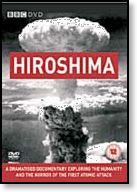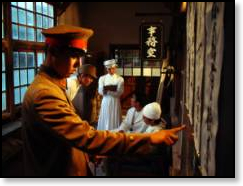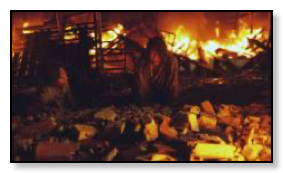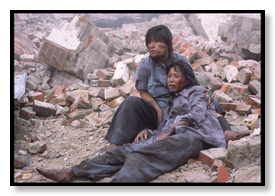HIROSHIMA (2005)

Writer/Producer/Director: Paul Wilmshurst
Executive Producer: Matthew Barrett
DoP: Graham Smith
90 mins, Super 16mm
TX August 2005
BBC Science for BBC One Co-production with TF1 (France), ZDF (Germany), Discovery (USA), CBC (Canada) and Tokyo Broadcasting System (Japan)
Landmark dramadoc telling the story of the atomic bomb and its impact on the people of Hiroshima. The film mixes testimony, archive, CGI and full-scale reconstruction to communicate the detailed content and context of this terrible event. The film was a year and a half in the making, with a substantial co-production budget and a necessarily ambitious canvas, story and effects. Screened in 30 countries around the world for the 60th anniversary of the bombing in August 2005.
Narrated by John Hurt; with George Anton, Ed Bishop, Kenneth Jay, Satchi Kimura, Haruka Kuroda, Naoko Mori, Ian Shaw, Kenji Watanabe
Winner International Emmy Award for Best Documentary 2006
Winner BAFTA Award for Best Visual Effects 2006
Nominated for Grierson Award for Best Drama Documentary 2006

For 90 minutes last night we were battered, horrified, moved to tears and driven to pity and anger by Hiroshima, a towering dramatised documentary by Paul Wilmshurst... In an accomplished and thrilling interwoven narrative style, with brilliant but chilling reenactments of the dreadful aftermath of the bomb, Hiroshima - wonderfully well-acted by a Japanese and American cast, supplemented by newsreel footage from the time and surviving witnesses - gave us the stories of the statesmen, the scientists, the aircrews and the unfortunate people of Hiroshima.
Daily Mail
A documentary about Hiroshima was hardly calculated to lift the spirits. Surprisingly it turned out to be very good, informative, and even entertaining, which was a peculiar experience. Dramatic reconstructions, which usually have my finger hovering over the fast forward button, were actually dramatic and made us think about issues and feelings rather than just wondering where the wigs came from. Actors portrayed politicians, servicemen and civilian victims of the atom bomb, and managed to get through some difficult scenes without ever looking awkward. The horrible job of recreating Armageddon was an object lesson in imaginative understatement and the judicious use of computer graphics; charred extras staggered around in the post-nuclear murk, buildings were splintered and bloated corpses bobbed like apples in a pond.The documentary side of things played well against the drama, which is not always the case. John Hurt's voiceover told us all we needed to know about the failures of diplomacy on both sides that led to the deployment of the bomb, while survivors and witnesses told their story to camera with dignity and candour. Of course there were tears during the accounts of rescue and bereavement - but equal weight was given to the painful honesty of Colonel Paul Tibbets and the rest of the Enola Gay crew, who were never demonised. The bomb fell almost exactly half-way through the 90-minute film, and what had hitherto been a story of military courage and political contempt turned into a sober account of the mounting horrors of the new nuclear age. Open sensationalism was avoided, apart from in a few archive clips - but the image of the survivors gratefully drinking the thick, black, radioactive rain that followed the blast will remain in the mind's eye for a long time to come. Writer, producer and director Paul Wilmshurst found a creditable balance between sober storytelling and contemporary comment, pointing out only once.... that very little seems to have been learned in the 60 years since the bomb fell. The hopeful closing image of remembrance candles floating down Hiroshima's rivers was a fittingly serene ending, but I can't have been the only viewer wondering if closure of any kind has been reached in our war-hungry world.
Guardian
An ambitious 90-minute docudrama that describes what happened on August 5, 1945, when the first atomic bomb was dropped on Hiroshima. The bomber crew remember what a beautiful morning it was, and a Japanese doctor treating a patient six kilometres away saw the aircraft “like a tiny silver drop” in the sky above the city. The eyewitness accounts of its devastating effect belong in a vision of hell. Mothers saw their children trapped in the rubble and burned alive. The city was filled with the sound of people crying out for water. When the rain fell like black treacle, the survivors drank it in desperation, unaware that it was poisoned. Later, the mayor of Hiroshima issued a proclamation. “The damage is great,” he said, “but that is only to be expected during a war. Keep up your spirits. Do not lose heart.”
The Times
Without doubt, Hiroshima is the most fair and balanced comprehensive presentation yet produced of what has become one of history's most controversial events. It is also a dynamic example of the inherent power of film media to inform and enlighten in an interesting and absorbing manner. All of the latest and most effective techniques in documentary film production - historical participant interviews, docu-drama recreation, archival film footage and state-of-the-art computer graphics (CGI) - are combined in BBC Video's Hiroshima by a producer of skill and vision into a riveting film that captures viewers' attention from the first frame and firmly holds it until the end. One might be tempted to call it entertaining due to the visual appeal of its colorful and expertly done CGI, but the film's grim subject matter makes that term highly inappropriate. Visually stunning, historically and scientifically accurate, and powerfully presented, BBC Video's Hiroshima is an expertly produced must have DVD that is clearly deserving of its 5-Star rating.
Jerry D. Morelock Editor in Chief, Armchair General magazine

IT IS not for a TV critic to debate the rights and wrongs of world affairs, but it was very hard to remain unmoved throughout Sunday night’s Hiroshima (BBC One). Narrated by the actor John Hurt, a man whose career has been defined by his ability to portray suffering with dignity, this docudrama provided an emotive version of the terrible event that took place on August 6, 1945. It was Hurt’s excellent narration that helped to set the sorrowful tone for 90 minutes of simultaneously fascinating and dreadful television. The format was the now familiar one of live interviews interspersed with real and imagined footage. There were one or two lapses into mawkishness, the worst of which was a dramatised account of a mother watching helplessly as her children burnt to death, but otherwise the focus was evenly distributed between Japanese survivors and the men of the flight squadron that deployed the bomb. Their accounts were all memorable, but most moving of all were those of the survivors. There was the boy who, having been rescued from the rubble of his school by a soldier, was miraculously reunited with his father; the young doctor who, called to tend to a girl several miles outside the city, witnessed the burning flash and mushroom cloud; the bank clerk who survived thanks to the protection of her earthquake-proof office. The fact that each of them had lived through one of the worst atrocities the world has ever witnessed gave them an almost mystical quality. They were living proof of the resilience of the human spirit, and seemed to harbour very little bitterness — although it might well be that it is simply not in the culture of that generation of Japanese to express such sentiments. By contrast, the American airmen appeared more hardened by the experience, although there is no doubt that they too were ultimately victims of its destructive power. Particularly interesting was the testimony of Paul Tibbets, the man who piloted the B29 bomber, which he named after his mother Enola Gay Tibbets. His stance remains aggressively defensive, arguing that President Truman’s decision to drop the bomb ultimately saved many more lives than the 100,000 it destroyed. In the context of a film that highlighted so eloquently the human suffering of his actions, it was a difficult view to identify with, but one that needed to be confronted.
The Times
"Ich war dabei, den Schreibtisch zu wischen, als die Bombe fiel", erinnert sich Akiko Takakura. Nur wenig später liegt die 19 Jahre alte Bankangestellte inmitten von Trümmern, draußen vor der Tür sieht sie die Hölle auf Erden: Das ZDF zeigt zum 60. Jahrestag des Atombomben-Abwurfs über Hiroshima am Dienstag (20.15 Uhr) das 90-minütige Doku-Drama "Hiroshima". Der britische Regisseur Paul Wilmshurst hat dafür historische Aufnahmen, Interviews mit japanischen Überlebenden und beteiligten US-Soldaten sowie szenische Rekonstruktionen verknüpft. Sein aufwändig produzierter Film setzt auf starke Emotionen und dokumentiert das Grauen mit eindrucksvollen Bildern. Auf Aussagen heutiger Politiker verzichtete Wilmshurst bewusst.
Die Herausforderungen bei der Umsetzung des Themas waren nach seinen Worten vielfältig - so die Frage nach der Darstellbarkeit der Katastrophe. "Wir wollten unsere Zuschauer sensibilisieren und gleichzeitig faszinieren", betont der Regisseur und Autor. Bei einem Dokumentarfilm mit Archivmaterial und Aussagen von Zeitzeugen wollten es die Filmemacher nicht belassen. Sie nahmen sich vor, die Ereignisse des Tages selbst "wieder zum Leben zu erwecken", denn die ersten Filmaufnahmen aus Hiroshima wurden erst Tage später aufgenommen. Das Genre Doku-Drama sei hierfür die "ideale Form", findet der Leiter des ZDF-Programmbereichs Zeitgeschichte und Zeitgeschehen, Guido Knopp. Es sei wichtig, die Geschichte einem größeren Publikum nahe zu bringen, betont der zuständige BBC-Redakteur Matthew Barrett. Gedreht wurde in Japan, vor allem aber in Polen mit japanischen Schauspielern und Statisten. Auch mit Spezialeffekten und Computeranimationen arbeitet der Film, der an dramaturgischen Mitteln nichts auslässt.
"Hiroshima" beginnt mit dem US-Atomtest in der Wüste New Mexicos im Juli 1945 und schildert die Weigerung der Japaner zu kapitulieren. Es folgen die minutiöse Vorbereitung der US-Militärs auf den Abwurf, der Flug des auf den Namen "Enola Gay" getauften Bombers, der die mehr als vier Tonnen schwere Bombe an Bord hatte - und schließlich das Inferno in Hiroshima nach dem ersten Abwurf einer Atombombe über einer bewohnten Stadt. Einer der US-Zeitzeugen ist der damalige Pilot, Colonel Paul Tibbets. "Ungeachtet der Zahl von Menschen, die wir getötet haben, haben wir einer vielfach größeren Menge von Menschen den Kriegseinsatz erspart und verhindert, dass noch mehr sterben mussten, auf amerikanischer und auf japanischer Seite", ist seine Meinung.
Dies sei wohl der letzte Jahrestag, an dem Zeitzeugen auftreten könnten, betont ZDF-Historiker Knopp. So gehören denn auch die Schilderungen der Überlebenden, die von nachgespielten Szenen illustriert werden, zu den eindringlichsten Momenten. Ein damaliger Schuljunge erzählt, wie er wie durch ein Wunder seinen Vater wieder fand. Die frühere Krankenschwester Kinuko Doi, die inzwischen gestorben ist, konnte jahrelang nicht über die Ereignisse sprechen. Und Takakura erinnert sich: "Ich fragte mich damals, warum nur? Und fand keine Antwort".
RP online Nachrichten

Visit Hiroshima Peace Museum website
Visit Enola Gay pilot Paul Tibbetts' website
Buy Hiroshima DVD at Virgin
Read Amazon reviews of the DVD
Read Guardian review in full
Read Gavin Rees's Guardian article about researching the programme
Read Armchair General review in full
Read transcript of discussion at Frontline Club on trauma and filming
Download mp3 of Frontrow discussion on Radio 4 reviewing the film
Read Showreel article about making Hiroshima
Read Guardian coverage of the International Emmy Awards
Read review in Hamburger Abendblatt
